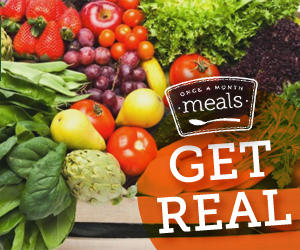**This post is part of the Get Real series. Please remember that this is meant as a learning community. We know that many of you are passionate about what you do and we want you to express that, just please do so in a way that will be an encouragement and aid to others making a transition. We want this to be a “safe space” for participants to learn. For that reason, we reserve the right to delete any comments that are not handled in this manner.
First off, let go of anything you’ve heard about canning being scary or dangerous. Right now, we’re only talking about the home canning of high-acid things like jams, pickles, tomatoes, and fruit in syrup. Botulism, that fearsome bacterium, cannot grow in high-acid environments. This means that it will not develop in your carefully canned strawberry jam. You can safely share it with friends, content in the knowledge that it will cause them absolutely no harm. Here’s what you’ll need to get started canning.
- Tongs
- A wide-mouth funnel
- A few measuring cups
- A jar lifter
- A large, wide, non-reactive pot like an enameled dutch oven for cooking jams and jellies
- A deep stockpot fitted with either a round cake cooling rack or a kitchen towel
Now that you have your tools in place, some tips to set you off on the right path.
- Work with the freshest produce around. Take care not to purchase more than you can process in a 48-hour period.
- Always can what’s in season. In my area, that means you make your pickled asparagus in May, strawberry jam in June, and put up as many tomatoes as you can manage during August and September.
- It can be a challenge to keep your pickles crisp. Cut off the blossom end of cucumbers and slip a grape leaf into each jar for optimum crunch.
- When making any sweet preserve with bits of fruit or peel in it, stir it off the heat for at least a minute when the cooking time is up. This helps evenly distribute those bits throughout.
- When processing your canned goods, never start your timer until the water has returned to a boil.
- If your recipe calls for a processing time of 10 minutes or longer, you do not have to use sterilized jars, just clean ones. If the processing is less than that, make sure to sterilize the jars by boiling them for 10 minutes.
- Never pour hot preserves into cold jars. The heat shock can cause the jars to break.
- Once the jars have cooled completely, always check to ensure that they’ve sealed completely. Do this by removing the band and gently wiggling the lid. A good seal means that it will not budge.
- Always store jars in a cool, dark place without the bands. This allows you to more easily see any bad seals or bulging lids.
When it comes to picking out your first couple of canning recipes, I recommend starting with sturdy vegetables for pickling and high pectin fruits for jam. These will give you the best, most fool-proof results. Green beans, cauliflower, okra, and zucchini all withstand the rigors of the boiling water bath better than cucumbers do and will remain crunchy after months on the shelf. Blueberries, raspberries, and apples are all quite high in pectin, which means that even if you’re not sure how exactly to find the set point for jam, you’ll still end up with a product that’s thick enough to spread. To get you started on your path, here’s my favorite pickle recipe.
Dilly Beans
Makes 4 pint jars
- 2 pounds green beans
- 2 1/2 cups distilled white vinegar
- 3 tablespoons pickling salt
- 1 teaspoon cayenne pepper
- 4 teaspoons dill seed (not dill weed)
- 4 garlic cloves, peeled
Prepare a boiling water bath and 4 regular-mouth jars. Place the lids in a small saucepan, cover them with water, and simmer over very low heat. Wash and trim the beans so that they fit in your jars. If you have particularly long beans, your best bet for minimum waste is to cut them in half, although by doing so, you do lose the visual appeal of having all the beans standing at attention. Combine the vinegar, 2 1/2 cups water, and pickling salt in a pot and bring the brine to a boil. Meanwhile, pack the beans into the sterilized jars, leaving 1/2 inch headspace. Add 1/4 teaspoon cayenne pepper (more if you’re a lover of heat), 1 garlic clove, and 1 teaspoon dill seed to each jar. Slowly pour the hot brine over the beans in each jar, leaving 1/2 inch headspace. Gently tap the jars on a towel-lined countertop to help loosen any bubbles before using a wooden chopstick to dislodge any remaining bubbles. Check the headspace again and add more brine if necessary. Wipe the rims, apply the lids and rings, and process in a hot water bath for 5 minutes. Let these pickles cure for at least 2 weeks before eating.
August Week Two Action Item:
Each week we will try to give you some simple action steps to put this journey into practice. It is important that you start this journey by understanding yourself, your goals, and perhaps your obstacles.
- Try another simple canning recipe and see what you think! Did you try something last week? What is keeping you from trying canning?
August Get Real:
Please take a moment to thank our guest authors by clicking over to their sites and/or liking them on Facebook and/or Twitter.
Sponsor: Once A Month Meals